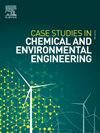柠檬酸改性水葫芦(Eichhornia crassipes)氢炭吸附去除水中镉(II
Q1 Environmental Science
Case Studies in Chemical and Environmental Engineering
Pub Date : 2025-07-28
DOI:10.1016/j.cscee.2025.101267
引用次数: 0
摘要
研究了水葫芦(Eichhornia crassipes)的生物吸附剂的合成。得到了三种生物吸附剂:柠檬酸修饰WH-CA、碳化WH (WHHC)和CA修饰WHHC (WHHC-CA)。确定了这些生物吸附剂从水溶液中吸附Cd(II)的能力。分别使用2、1和0.5 M CA溶液对WH和WHHC进行水热改性,并使用CA浓度进行命名。使用各种技术对所有生物吸附剂进行了表征。在pH = 6和25℃条件下,WHHC-CA1对Cd(II)的吸附量最高,为166.6 mg/g,最佳CA浓度为1 M。本文章由计算机程序翻译,如有差异,请以英文原文为准。

CADMIUM(II) removal from aqueous solution by adsorption on water hyacinth (Eichhornia crassipes) hydrochar modified with citric acid
This study is focused on synthesizing biosorbents from water hyacinth (Eichhornia crassipes), WH. Three biosorbents were obtained: WH modified with citric acid (WH-CA), hydrocarbonized WH (WHHC), and WHHC modified with CA (WHHC-CA). The capacity of these biosorbents to adsorb Cd(II) from water solutions was ascertained. WH and WHHC were modified hydrothermally using 2, 1 and 0.5 M CA solutions and were designated using CA concentration. All biosorbents were characterized using various techniques. At pH = 6 and 25 °C, WHHC-CA1 exhibited the highest capacity for adsorbing Cd(II) of 166.6 mg/g, so the optimal CA concentration is 1 M.
求助全文
通过发布文献求助,成功后即可免费获取论文全文。
去求助
来源期刊

Case Studies in Chemical and Environmental Engineering
Engineering-Engineering (miscellaneous)
CiteScore
9.20
自引率
0.00%
发文量
103
审稿时长
40 days
 求助内容:
求助内容: 应助结果提醒方式:
应助结果提醒方式:


